It’s taken a while to come together, and the entry threshold is pretty steep. But Twitter’s new creator ad share payouts are now starting to flow through – and given the amounts being shared, Twitter’s delayed rollout strategy for the scheme actually makes a lot of sense.
As a quick recap, back in February, Twitter owner Elon Musk announced that Twitter would begin sharing ad revenue with participating Twitter Blue subscribers, as part of its broader creator monetization push.
Starting today, Twitter will share ad revenue with creators for ads that appear in their reply threads
— Elon Musk (@elonmusk) February 3, 2023
We didn’t get much more detail on the program till June, when Musk announced that Twitter would soon make its first creator payments for ads served in replies to verified users only, with the initial block payment set to come in at $5 million.
Then this week, further details outlined the thresholds for qualification for the program, with participating creators needing to have generated at least 5 million tweet impressions per month for three consecutive months.
Which is a lot, but there may actually be method to this, with the first payouts being reported by Twitter users today, with some reaching $25k, $30k, and even more in some cases.

Those are some big numbers, which will spark a lot more interest from top Twitter users, who’ll now be looking into how they too can get a piece of the pie. Which will prompt more top tweeters to tweet even more often, in order to boost their potential – but it is worth noting that the payments have been backdated to Musk’s original announcement back in February, so you’re actually looking at 5 months-worth of ad revenue share, which means that these are likely a lot higher than the normal payment amounts creators can expect.
Which is why Twitter’s approach, which seemed to be due to internal challenges in implementing the program, is actually quite clever.
By paying out five months of revenue share all at once, and restricting these payments to the most engaged users, that’ll make all of the reported payouts look really good, which will get a lot more people interested in the program.
You can bet that a heap more frequent Tweeters would love to see a payout like that, which will then get them all tweeting even more often, in the hopes that they too can spark more engagement, and get more ads shown in their replies.
Which could also be problematic, in terms of the types of content the program then incentivizes.
Research has shown that high arousal emotions, like anger and happiness, are the key drivers of comments on web posts, with negative emotions driving more virality – meaning that the best way to maximize the amount of comments and replies is to post things that make people angry enough to respond.
So in effect, sharing ad revenue based on the number of ads displayed within tweet replies will likely incentivize more argument – which could be good for Twitter, as all engagement is beneficial. But it probably won’t help to make the platform a more civil space, nor a most trustworthy source, as more users will simply be looking to incite rage with their divisive takes.
But having users post their large payouts is certainly a win for the program, and the current restrictions on participation have amplified this. On that front, Twitter says that it’ll be giving more users access to its ad revenue share program soon.
Maybe you too could get paid. You just need to be verified, and you need to generate a lot of tweet engagement – good or bad.
Time to heat up those hot takes.
Note for creators: At present, you need to have subscriptions enabled to access the ad revenue share program. This is being updated shortly to separate the two elements.



